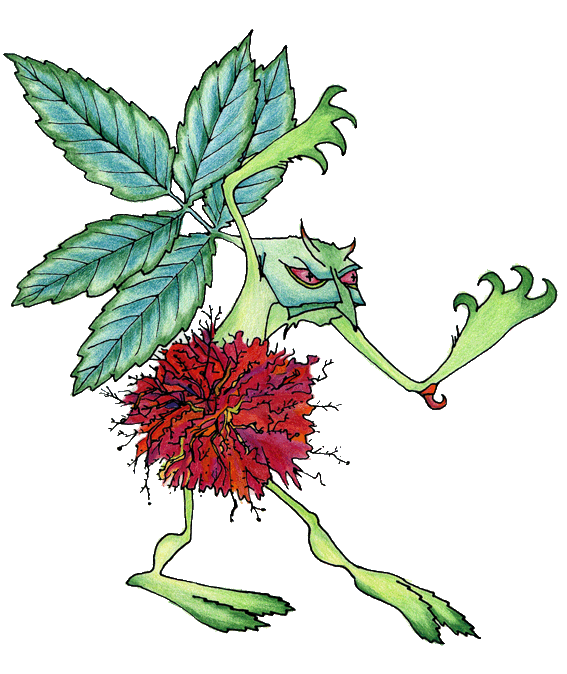| Adelges abietis is a rather common species on spruce (Picea abies). The needles are shortened and thickened and are spaces closely together, which is why it lookes a bit like a cone. In August or September the galchambers open and the aphids emerge. There are usually two or three galls on one branch, at the base or outher parts of young shoots. The young shoots remain to grow, also from the gall. | | 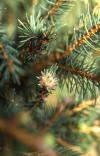
(Pictures: T.J.M. Janson) 
|
|
Adelges nordmannianae, is a species that seen on Picea orientalis every now and then. The gall is much more compact than the previously mentioned Adelges-species. It is describes as being rather rare for England, but I don't think this is the case in the Netherlands. I have seen the species in the Hortus Haren (Gr.) and Theo Janson and Leo Goudzwaard (pinetum Schovenhorst, Putten) made the picture's you can see on the right. The gall grow from the short side-branches and also consist of strongly (at the base) thickened needles. The whole of the branch disappears in the gall and the tip ends of the neadles are hardly developed. The gall are 6 tot 8 mm tall. Abies-species are in-between host species, but the leafaphis does not develop galls on these hosts (DvL). | | 
(Picture: T.J.M. Janson)
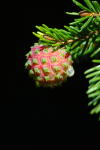
(Picture: L. Goudzwaard)
|
|
| Adelges virides (sacchiphantes) is a wide spread aphid on Picea abiesthat causes galls to form at the ends of branches, but with a little tip of the branch, or a lot of branch on top of the gall. The branches on top of the gall remain alive and growing. The needles swell at their base and grow together. Behind every broadening needle is a cavity, where the aphids live. The cavity opens en closes several times. The gall is bald and has the appearance of a pineapple and becomes about ten millimeters wide. Around the edged of the cavities there is usually some red colouring. I made this picture in Grachen, Switserland. | | 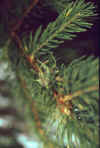 |
|
| Aphis rumicis - The leaves are irregularly curled downwards from the edges and has a wrinkled appearance because of extra tissue in between the veins. The species is common on Rumex obtusifolius and also occurs on other big-leave Rumex-species. The aphids are black. | | 
(Pictures: B. Kabbes) |
|
| Brachycaudus tragopogonis is an aphid that makes the leaves of Prunus spinosa wrinkle downward. This usually occurs on young shoots. Inside the curl are many aphids. | | |
|
| Cryptomyzus ribis is an aphid which causes red and yellow coloured pouches to appear on the upper side of the leaves of Ribes rubrum and R. americanum. The pouches blend to bigger pouches. The gall is said to be common. This picture was taken in Fryslan and I have seen a specimen myself in Stedum, Groningen. | | 
(Picture: B. Kabbes) |
| | |
|
| Eriosoma lanuginosa on Ulmus minor induces an impressive gall which uses the entire leaf to form the gall. A large sack appears that is covered with short hairs. In the beginning the gall is pale green and often also slightly red. When the gall becomes mature, the gall bursts open and the aphids are free to leave. Inside, the walls are covered with honeydew. After the aphids have left, the gall turns brown and will stay on the tree until the next year. | | 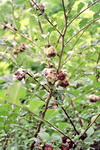
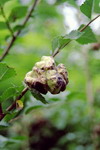
Pictures: R.J. Koops
|
| | |
|
| Eriosoma ulmi is one of the leaf roling aphids on elm - Ulmus. One side of the leaf is inrolled and thickened, causing halve or sometimes the whole leaf to be galled. The leaf roll colours pale green or white-green and contains aphids with wax. The aphids are first green and later brown. Common. | | 


|
|
Gilletteella (Adelges) cooleyi causes long shaped deformations on different species of Picea. On the many planted trees of Picea sitchensis in the Netherlands the gall is very common. | | 
|
|
| Pemphigus bursarius - On Italian or Black Poplars many gall forming aphids can be found and most of them are really spectacular. Pemphigus bursarius creates a major enlargement, usually on the leaf stem. | | 


|
| | |
|
| Pemphigus populinigrae causes galls on the midrib of Populus nigra. On the upperside of the leaf is a elongate pouch, about one cm high and several cm long. The gall is pale green to red. The opening is below and in June - August the aphids emerge. The winged aphids are dark green and the nymphs are grey. | |  |
|
| Pemphigus spyrothecae - The leaf stalk of Populus nigra is broadened and winded into a spiral. The edges of every wind is growing tight together en thus closes the gall chamber. The gall can become to 30 mm long and 12 mm wide. Sometimes the galls are coloured red. The species is described to be common. The gall contains wingless aphids in July, and some aphids with wings in August. | | 

|
|
Tetraneura ulmi causes beautiful stalked,club-shaped galls on Elm (Ulmus) (Redfern, Shirley, Bloxham, 2002), usually on the upper side of the leaf blade, away from the midrib. When the galls are fully developed the aphids leave through a hole near the base of the gall on one side of the club. The galls become 7 to 15 mm tall and the leaf thickens and turns yellow around the stalk. The aphids are waxy, grey-black above, green-yellow below. Locally the aphids are common. When the galls are immature they resemble green peas... | | 
Picture: A. van Vugt

Picture: Marja Garrelds


Pictures: R.J. Koops
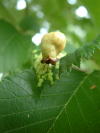
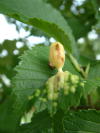
|
| | | |
 Nederlands
Nederlands
